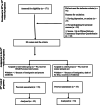The effect of midwifery led counseling based on Gamble's approach on childbirth fear and self-efficacy in nulligravida women
- PMID: 32907547
- PMCID: PMC7488155
- DOI: 10.1186/s12884-020-03230-1
The effect of midwifery led counseling based on Gamble's approach on childbirth fear and self-efficacy in nulligravida women
Abstract
Background: Studies show that childbirth fear is a common problem among Iranian women. Therefore, most Iranian women prefer caesarean section for giving birth. This study investigated the effectiveness of a psychoeducational intervention by midwives (birth emotions - looking to improve expectant fear (BELIEF)) on decreasing childbirth fear and self-efficacy among first-time pregnant women who were afraid of giving birth.
Methods: A number of 80 pregnant women participated in the study. They had received a score of ≥66 on the Wijma delivery expectancy/experience questionnaire. They were randomly assigned into two groups: intervention (n = 40) and control groups (n = 40). The intervention group received two face-to-face counseling sessions based on the BELEF protocol in the 24th and 34th weeks of pregnancy. Between these two sessions, it also received eight telephone-counseling sessions once a week. The control group only received the prenatal routine care. The outcome measures were childbirth fear, childbirth self-efficacy, and childbirth preference.
Results: The intervention group showed significantly more reduction in childbirth fear and more increase in childbirth self-efficacy compared to the control group. In addition, more women in the intervention group reported that they preferred to give normal vaginal birth than women in the control group.
Conclusion: The BELIEF protocol could be an effective approach in reducing childbirth fear and increasing childbirth self-efficacy among first-time pregnant women who are afraid of giving birth.
Trial registration number: IRCT20101219005417N3, Date of Registration: 19-12-2018.
Keywords: BELIEF protocol; Childbirth fear; Childbirth self-efficacy; Iran.
Conflict of interest statement
The authors have no actual or potential conflicts of interest including any financial, personal or other relationships with other people or organizations within 3 years of beginning the work submitted that could inappropriately influence their work.
Similar articles
-
Study protocol for reducing childbirth fear: a midwife-led psycho-education intervention.BMC Pregnancy Childbirth. 2013 Oct 20;13:190. doi: 10.1186/1471-2393-13-190. BMC Pregnancy Childbirth. 2013. PMID: 24139191 Free PMC article. Clinical Trial.
-
A randomized controlled trial of a psycho-education intervention by midwives in reducing childbirth fear in pregnant women.Birth. 2014 Dec;41(4):384-94. doi: 10.1111/birt.12136. Epub 2014 Oct 9. Birth. 2014. PMID: 25303111 Free PMC article. Clinical Trial.
-
The effect of an mHealth application based on continuous support and education on fear of childbirth, self-efficacy, and birth mode in primiparous women: A randomized controlled trial.PLoS One. 2023 Nov 1;18(11):e0293815. doi: 10.1371/journal.pone.0293815. eCollection 2023. PLoS One. 2023. PMID: 37910495 Free PMC article. Clinical Trial.
-
Pregnant Women in Turkey Experience Severe Fear of Childbirth: A Systematic Review and Meta-Analysis.J Transcult Nurs. 2019 Sep;30(5):501-511. doi: 10.1177/1043659618823905. Epub 2019 Jan 17. J Transcult Nurs. 2019. PMID: 30651038
-
"I shut it out": expectant mothers' fear of childbirth after a traumatic birth-a phenomenological study.Int J Qual Stud Health Well-being. 2022 Dec;17(1):2101209. doi: 10.1080/17482631.2022.2101209. Int J Qual Stud Health Well-being. 2022. PMID: 35852421 Free PMC article. Review.
Cited by
-
An educational programme based on salutogenesis theory on childbirth fear and delivery method among nulliparous women: A mixed methods research protocol.Nurs Open. 2023 Mar;10(3):1909-1922. doi: 10.1002/nop2.1414. Epub 2022 Nov 6. Nurs Open. 2023. PMID: 36336796 Free PMC article.
-
The effectiveness of nurse-led antenatal education on maternal self-efficacy: an evidence-based approach.BMC Nurs. 2025 Jul 10;24(1):895. doi: 10.1186/s12912-025-03471-5. BMC Nurs. 2025. PMID: 40640815 Free PMC article.
-
Tocophobia: Risk Factors, Consequences and Management - A Systematic Review of the Literature.Maedica (Bucur). 2024 Jun;19(2):393-399. doi: 10.26574/maedica.2024.19.2.393. Maedica (Bucur). 2024. PMID: 39188830 Free PMC article. Review.
-
The significance of positional care combined with doula delivery during childbirth in the correction of abnormal fetal position.Am J Transl Res. 2024 Jan 15;16(1):190-199. doi: 10.62347/HNAQ1803. eCollection 2024. Am J Transl Res. 2024. PMID: 38322577 Free PMC article.
-
Enhancing Midwifery Students' Knowledge and Skills in Communication, Counselling, and Therapeutic Approaches Through an Elective Pilot Course: A Mixed-Methods Study.Healthcare (Basel). 2025 May 19;13(10):1180. doi: 10.3390/healthcare13101180. Healthcare (Basel). 2025. PMID: 40428016 Free PMC article.
References
-
- Nieminen K, Malmquist A, Wijma B, Ryding EL, Andersson G, Wijma K. Nulliparous pregnant women's narratives of imminent childbirth before and after internet-based cognitive behavioural therapy for severe fear of childbirth: a qualitative study. Bjog-Int J Obstet Gy. 2015;122(9):1259–1265. doi: 10.1111/1471-0528.13358. - DOI - PubMed
Publication types
MeSH terms
Grants and funding
LinkOut - more resources
Full Text Sources
Medical


